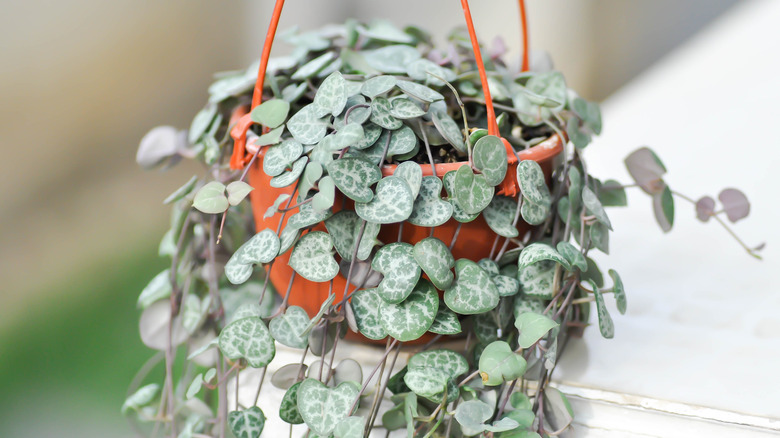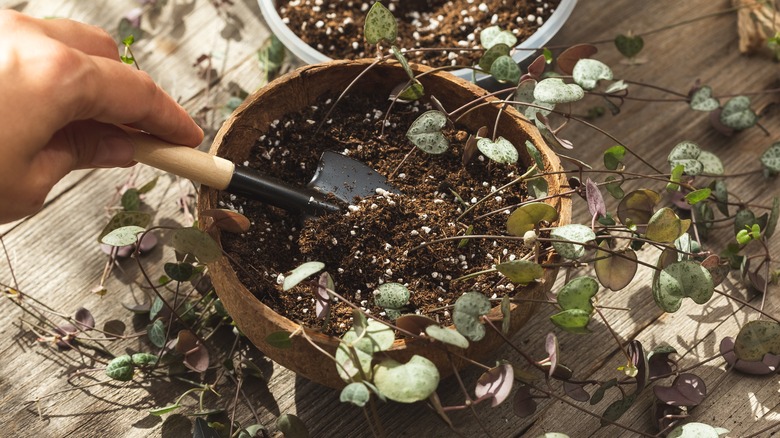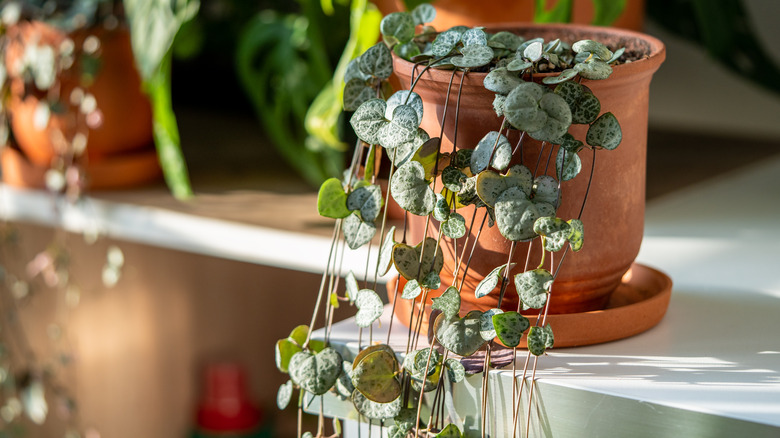Why Your 'Easy-To-Care-For' String Of Hearts Plant May Be Dying
The String of Hearts is a well-known and beloved house plant for its small heart-shaped foliage that showcases a marmoreal-like pattern. Whether variegated and boasting pinks and whites or non-variegated and contrasting in different shades of green, it is a stunning houseplant. Also called Chain of Hearts, Sweetheart Vine, and Rosary Vine, the plant is native to South Africa and is a part of the Apocynaceae family, which includes many vining and succulent plants. Because of its succulent qualities, the String of Hearts is both easy to care for and sensitive to its needs being met.
While the climbing vine is not necessarily high-maintenance nor hard to care for, it still needs a specific set of conditions to grow strong and healthy. Indirect bright light, temperatures between 60 to 80 degrees Fahrenheit, and watering when dry are really all the plant asks for. However, any form of overdoing or underdoing these needs can result in an unhappy houseplant and ultimately lead to its death. As soon as you notice something is amiss with your String of Hearts, it's important to pinpoint the issue and begin correcting it, whether the problem is due to overwatering, too much sunlight, unsuitable temperatures, or pests.
Why is your String of Hearts wilting?
An easy-to-care-for plant doesn't mean certain conditions won't have a negative effect. As a succulent, the String of Hearts will naturally tolerate dry and hot conditions more than overly moist and cold. Preferring bright indirect light, you'll find the vine suffering with too little or too much sunlight. Too much will lead to brown, crisp foliage, and too little will cause discoloration and eventually wilting. Temperatures that are too cold or too hot won't be ideal, and you should keep the plant no colder than 40 degrees and no warmer than 80 degrees Fahrenheit.
Overwatering is a very prevalent issue with most house plants. Too much water will cause yellowing leaves and root rot. When the plant goes dormant in fall and winter, scale back on watering and slightly increase when spring and summer roll back around. Drainage holes and ensuring the top ⅓ to ⅔ of the soil is dry before watering will be essential. Underwatering is also harmful and causes leaves to soften, thin, and curl inwards. If you keep an eye on this, it's easy to water the plant with minor damage done. Fertilizing will be beneficial, but like all things, don't overdo it. Fertilizer burn leads to stunted growth and dying foliage. Lastly, pests like aphids and spider mites are common among houseplants, sucking the sap from their leaves and slowly but surely causing their demise. Inspecting for pests regularly is wise to ensure they can immediately be resolved.
Reviving String of Hearts
Before attempting to reverse damage on your String of Hearts, you must identify the specific problem. While overwatering is one of the most common ailments, it's also one of the hardest to reverse. Remove the plant from its pot and inspect the roots for rot and mold. If found, gently snip away the affected roots to prevent decay from continuing to spread. Allow the healthy roots to dry out for a few hours, and then repot in entirely new soil. If you often overwater your plants, consider increasing drainage with rocks and perlite or avoid using trays beneath the pot, which traps water. Once repotted, the plant may not improve, and at this stage, it's best to propagate and save what you can.
Reversing impairment caused by sun-scorching and fertilizer burn is also challenging. With too much sun, all you can do is remove the burned foliage and move the plant to a better location. Fertilizer burn, however, can be flushed out with a couple of long waterings, allowing all surplus water to drain out. You may need to do this a few times, and afterward, avoid fertilizing for at least four weeks. Another approach when adding too much fertilizer is to rinse the roots and repot in new soil. When facing pests, two of the most common treatments are applying neem oil and insecticidal soap to the plant's affected areas. Applying this several times a week until the pests are gone will be sufficient.


